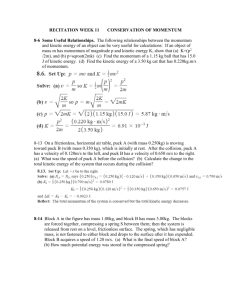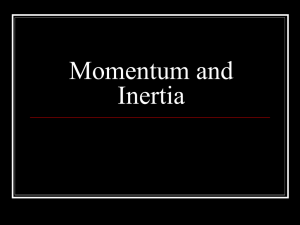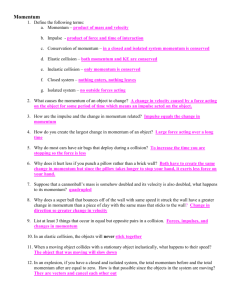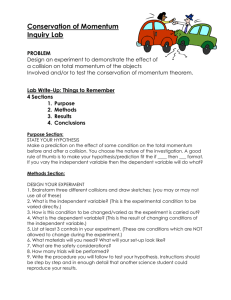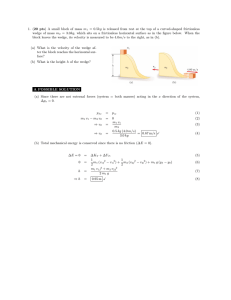Chapter 9 Solutions
advertisement
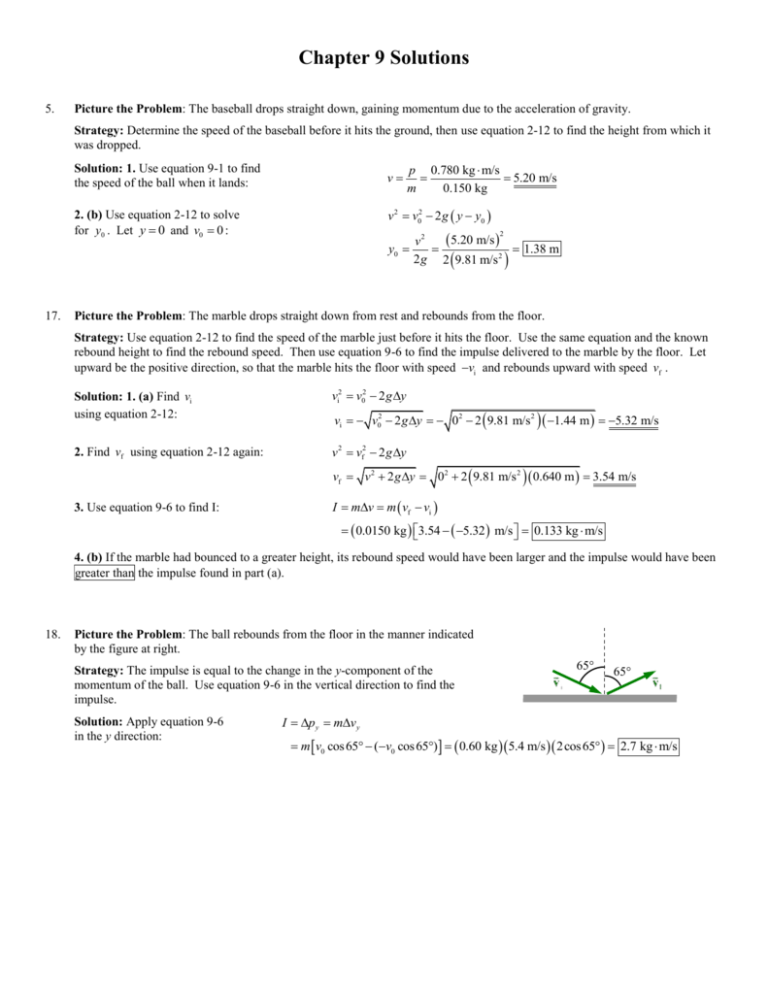
Chapter 9 Solutions 5. Picture the Problem: The baseball drops straight down, gaining momentum due to the acceleration of gravity. Strategy: Determine the speed of the baseball before it hits the ground, then use equation 2-12 to find the height from which it was dropped. p 0.780 kg m/s 5.20 m/s m 0.150 kg Solution: 1. Use equation 9-1 to find the speed of the ball when it lands: v 2. (b) Use equation 2-12 to solve for y0 . Let y 0 and v0 0 : v 2 v02 2 g y y0 17. 5.20 m/s v2 1.38 m 2 g 2 9.81 m/s 2 2 y0 Picture the Problem: The marble drops straight down from rest and rebounds from the floor. Strategy: Use equation 2-12 to find the speed of the marble just before it hits the floor. Use the same equation and the known rebound height to find the rebound speed. Then use equation 9-6 to find the impulse delivered to the marble by the floor. Let upward be the positive direction, so that the marble hits the floor with speed vi and rebounds upward with speed vf . Solution: 1. (a) Find vi using equation 2-12: vi2 v02 2 g y 2. Find vf using equation 2-12 again: v 2 vf2 2 g y vi v02 2 g y 02 2 9.81 m/s 2 1.44 m 5.32 m/s vf v 2 2 g y 02 2 9.81 m/s 2 0.640 m 3.54 m/s 3. Use equation 9-6 to find I: I mv m vf vi 0.0150 kg 3.54 5.32 m/s 0.133 kg m/s 4. (b) If the marble had bounced to a greater height, its rebound speed would have been larger and the impulse would have been greater than the impulse found in part (a). 18. Picture the Problem: The ball rebounds from the floor in the manner indicated by the figure at right. Strategy: The impulse is equal to the change in the y-component of the momentum of the ball. Use equation 9-6 in the vertical direction to find the impulse. Solution: Apply equation 9-6 in the y direction: 65° 65° I p y mv y m v0 cos 65 (v0 cos 65) 0.60 kg 5.4 m/s 2cos 65 2.7 kg m/s 22. Picture the Problem: The two skaters push apart and move in opposite directions without friction. Strategy: By applying the conservation of momentum we conclude that the total momentum of the two skaters after the push is zero, just as it was before the push. Set the total momentum of the system to zero and solve for m2 . Let the velocity v1 point in the negative direction, v 2 in the positive direction. p1x p2 x 0 m1v1x m2 v2 x m1v1x 45 kg 0.62 m/s m2 31 kg v2 x 0.89 m/s Solution: Set ptotal 0 and solve for m2 : 27. y Picture the Problem: The vector diagram at right indicates the momenta of the three pieces. Strategy: Because the plate falls straight down its momentum in the xy plane is zero. That means the momenta of all three pieces must sum to zero. Choose the motion of the two pieces at right angles to one another to be in the x̂ and ŷ directions. Set the total 225° x momentum equal to zero and solve for v 3 . Solution: 1. Set p 0 and solve for v 3 : p mv xˆ mv yˆ mv v3 32. 0 3 mv xˆ mv yˆ m v 2. Find the speed v3 : v3 3. Find the direction of v3 : tan 1 2 v 2 v xˆ v yˆ 2v v3, y 1 v tan 45 180 225 v v3, x Picture the Problem: The bullet collides with the block, passing right through it and continuing in a straight line but at a slower speed than it had initially. Afterwards the block moves with constant speed in the same direction as the bullet. Strategy: Use conservation of momentum to find the speed of the bullet after the collision. Because this is an inelastic collision we expect a loss of kinetic energy. Use equation 7-6 to find the initial and final kinetic energies and confirm the energy loss. Let the subscripts b and B denote the bullet and the block, respectively. Solution: 1. (a) Let pi pf and solve for vbf : mb vbi 0 mb vbf mB vBf m v mB vBf vbf b bi mb 0.0040 kg 650 m/s 0.095 kg 23 m/s 0.0040 kg 1.0 102 m/s 2. (b) The final kinetic energy is less than the initial kinetic energy because energy is lost to the heating and deformation of the bullet and block. 0.0040 kg 650 m/s 3. (c) Use equation 7-6 to find Ki : K i 12 mb vbi 2 4. Use equation 7-6 to find K f : K f 12 mb vbf 2 12 mB vBF 2 1 2 1 2 0.0040 kg 104 m/s 2 2 850 J 12 0.095 kg 23 m/s 47 J 2 34. Picture the Problem: The putty is thrown horizontally, strikes the side of the block, and sticks to it. The putty and the block move together in the horizontal direction immediately after the collision, compressing the spring. Strategy: Use conservation of momentum to find the speed of the putty-block conglomerate immediately after the collision, then use equation 7-6 to find the kinetic energy. Use conservation of energy to find the maximum compression of the spring after the collision. Solution: 1. (a) No, the mechanical energy of the system is not conserved because some of the initial kinetic energy of the putty will be converted to heat, sound, and permanent deformation of material during the inelastic collision. 2. Set pi pf and solve for vf : mp mp vp mb mp vf vf m m p b K after 0 0 U rest 3. Set Eafter Erest after the collision: 1 2 4. Solve the resulting expression for xmax : 37. vp m mb mp m pm p b xmax 2 2 1 2 vp 2 kxmax mp2 vp2 0.0500 kg 2 2.30 m/s 2 k mp mb 20.0 N/m 0.430 0.0500 kg 0.0371 m 3.71 cm 2 Picture the Problem: The truck strikes the car from behind. The collision sends the car lurching forward and slows down the speed of the truck. Strategy: This is a one-dimensional, elastic collision where one of the objects (the car) is initially at rest. Therefore, equation 912 applies and can be used to find the final speeds of the vehicles. Let m1 be the mass of the truck, m2 be the mass of the car, and v0 be the initial speed of the truck. 45. Solution: 1. Use equation 9-12 to find v1,f : m m2 1720 732 kg v1,f 1 v0 15.5 m/s 6.25 m/s vtruck 1720 732 kg m1 m2 2. Use equation 9-12 to find v2,f : 2 1720 kg 2m1 v2,f v0 15.5 m/s 21.7 m/s vcar m1 m2 1720 732 kg Picture the Problem: The bricks are configured as shown at right. Strategy: Use equation 9-14 to calculate the x-coordinate of the center of mass. Assume that the mass of each brick is m and that the mass of each brick is distributed uniformly. Reference all positions from the left side of the bottom brick, as indicated in the figure. Solution: Apply equation 9-14 directly: X cm mx m x m x m3 x3 m L2 L 54L 1 11L 11 L m1 m2 m3 3m 3 4 12 1 1 M 2 2 80. Picture the Problem: The hockey player tosses the helmet in one direction and recoils in the other. Strategy: The total horizontal momentum of the hockey player m p and helmet mh is conserved because there is no friction. The total horizontal momentum remains zero both before and after the helmet is tossed. Use this fact to find the mass of the player. Let the helmet be tossed in the positive direction. Solution: Set pi,x pf,x and solve for m p : p 0 mp vp, x mh vh, x mh vh, x 1.3 kg 6.5 m/s cos11 mp 33 kg vp, x 0.25 m/s x


